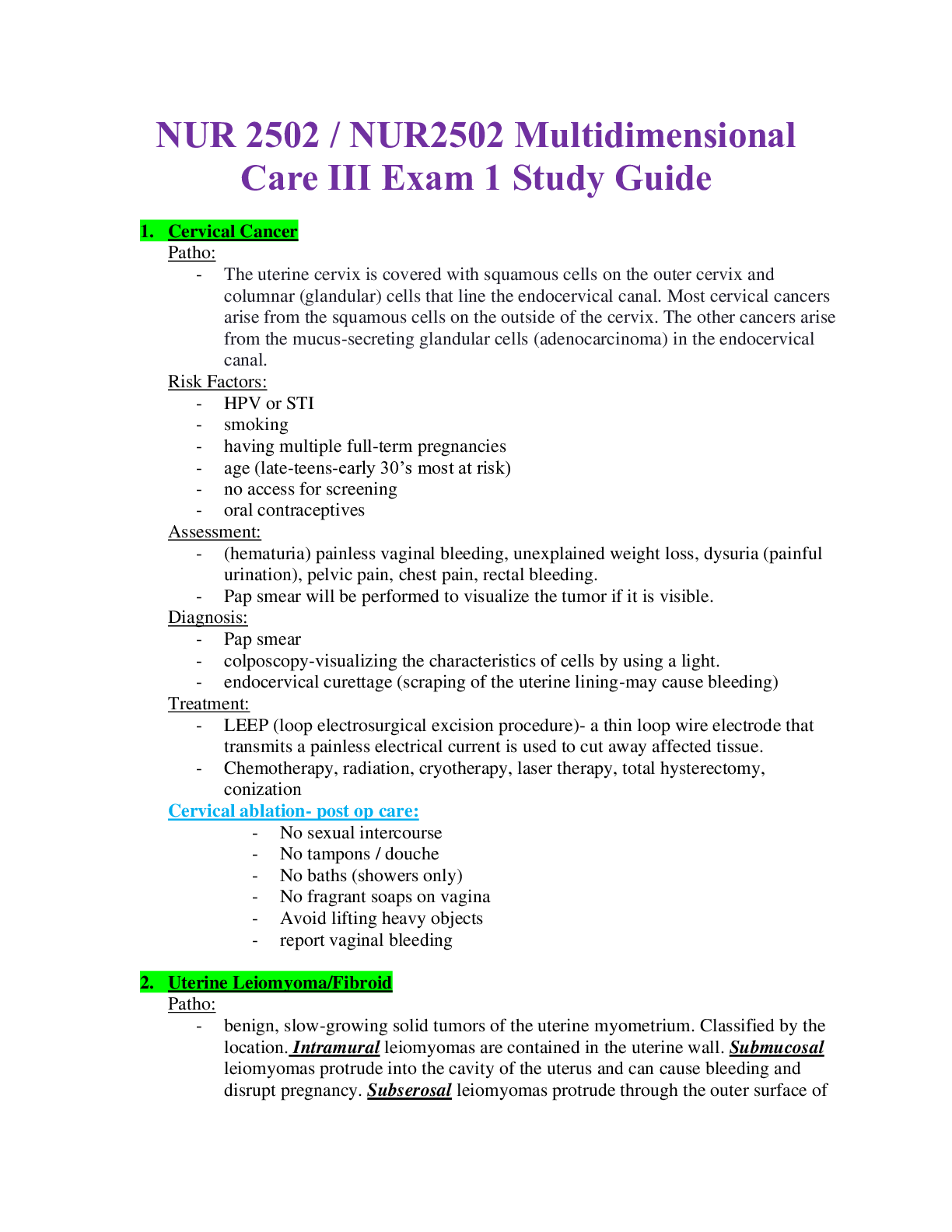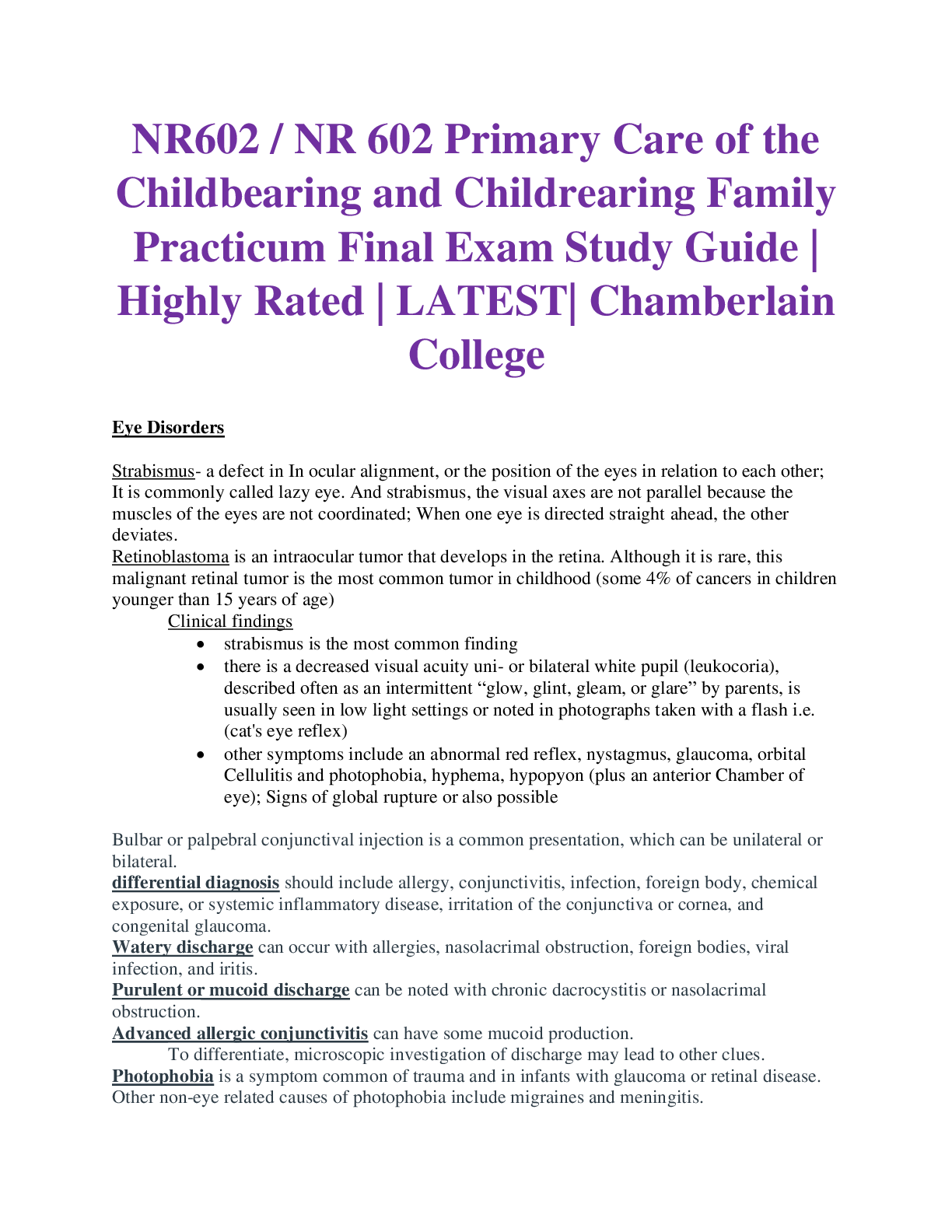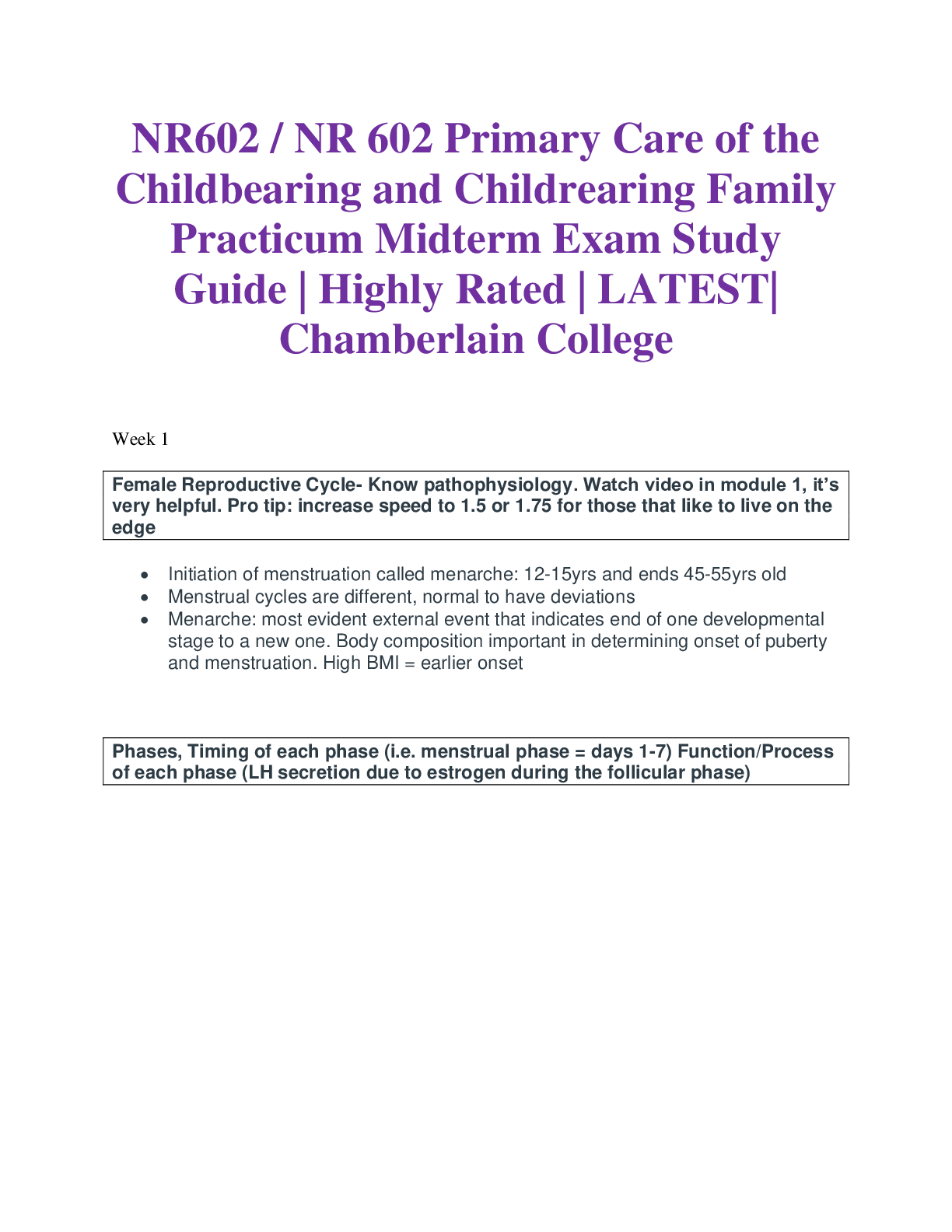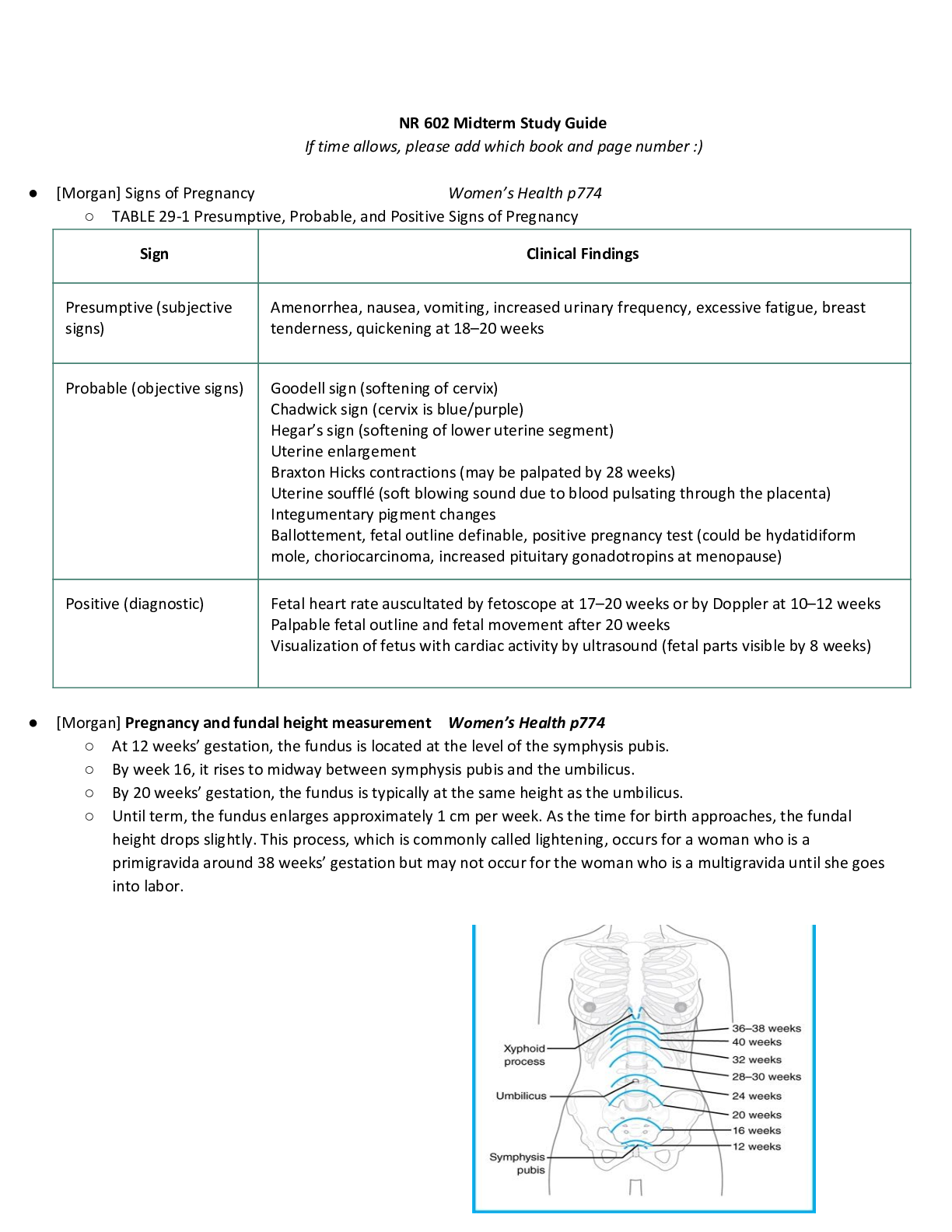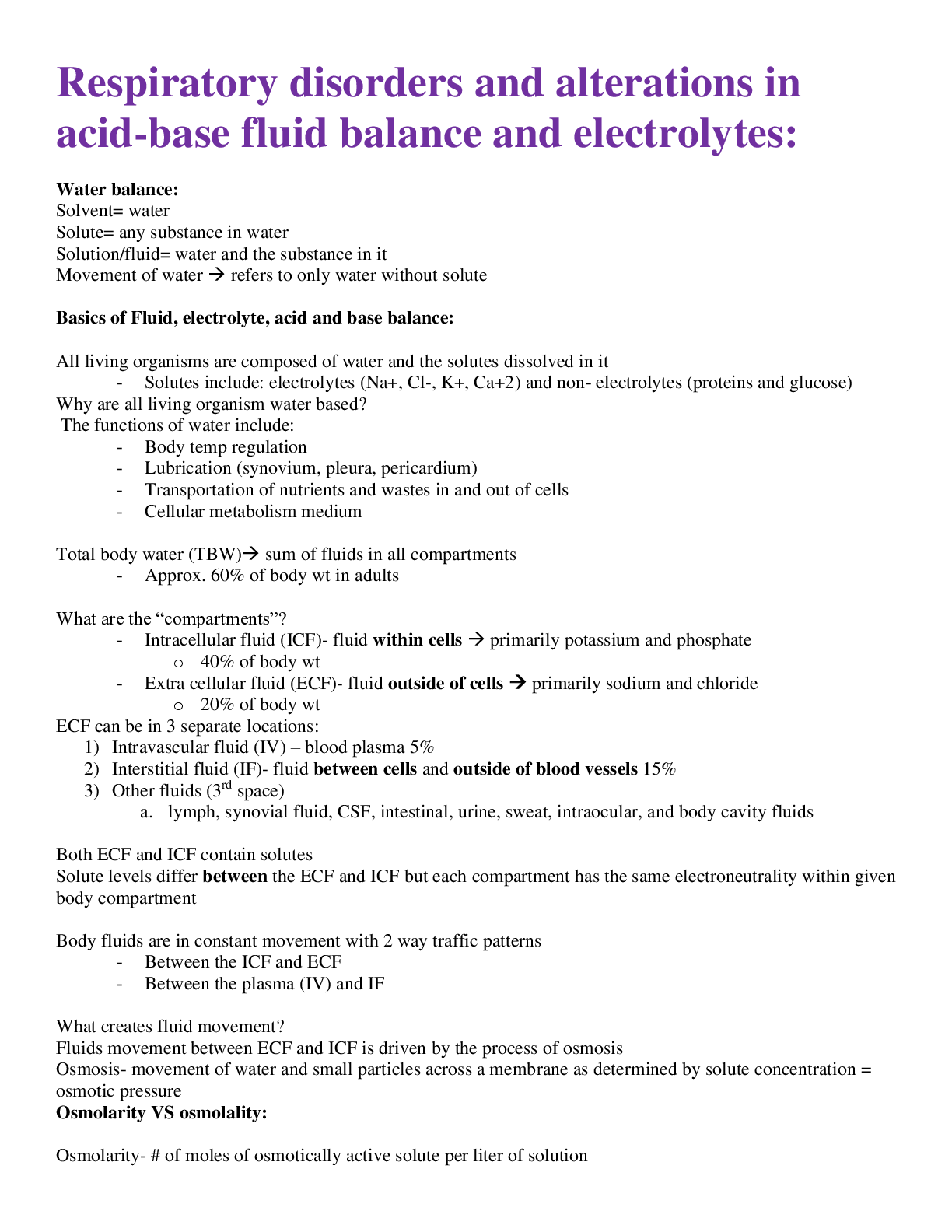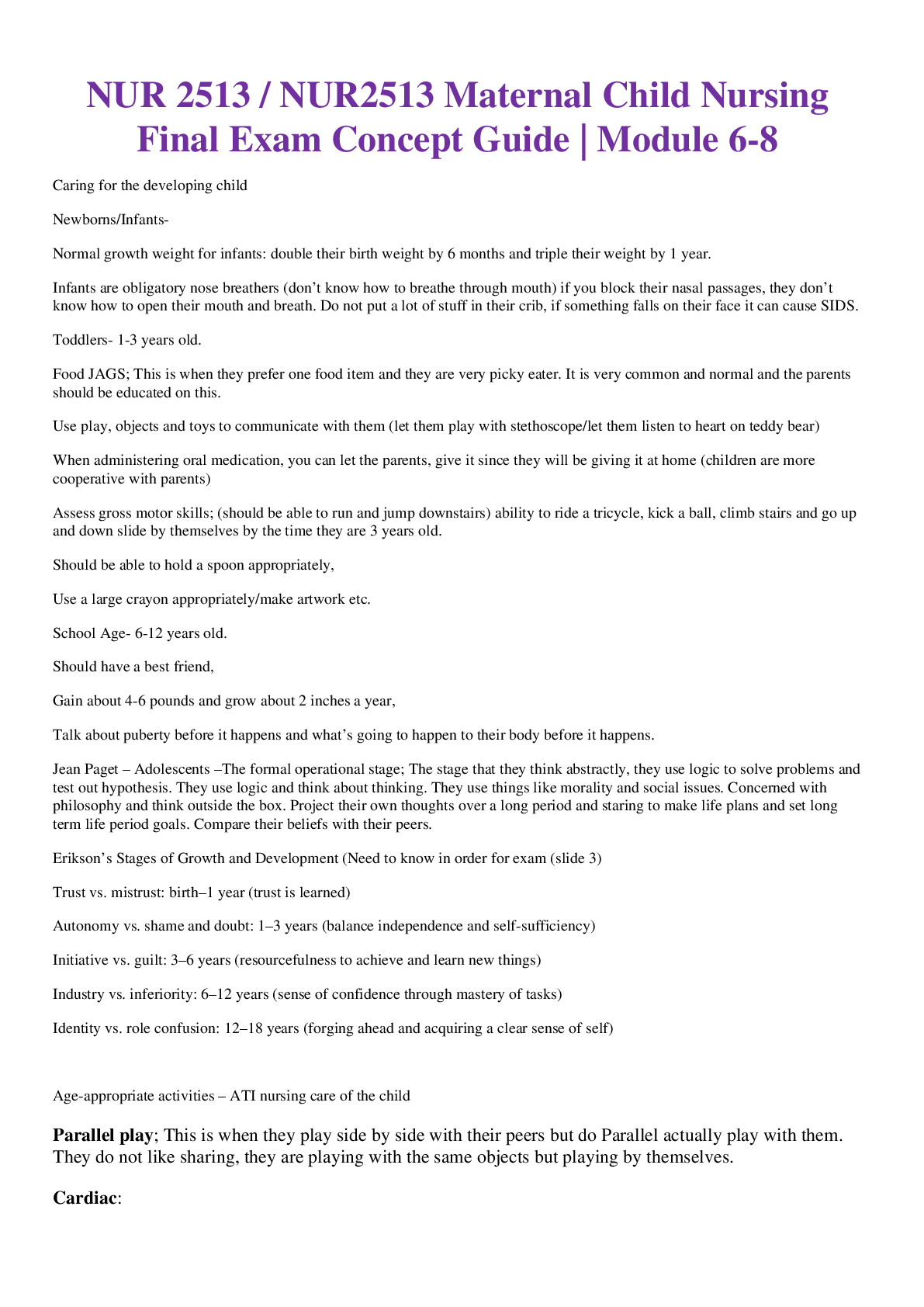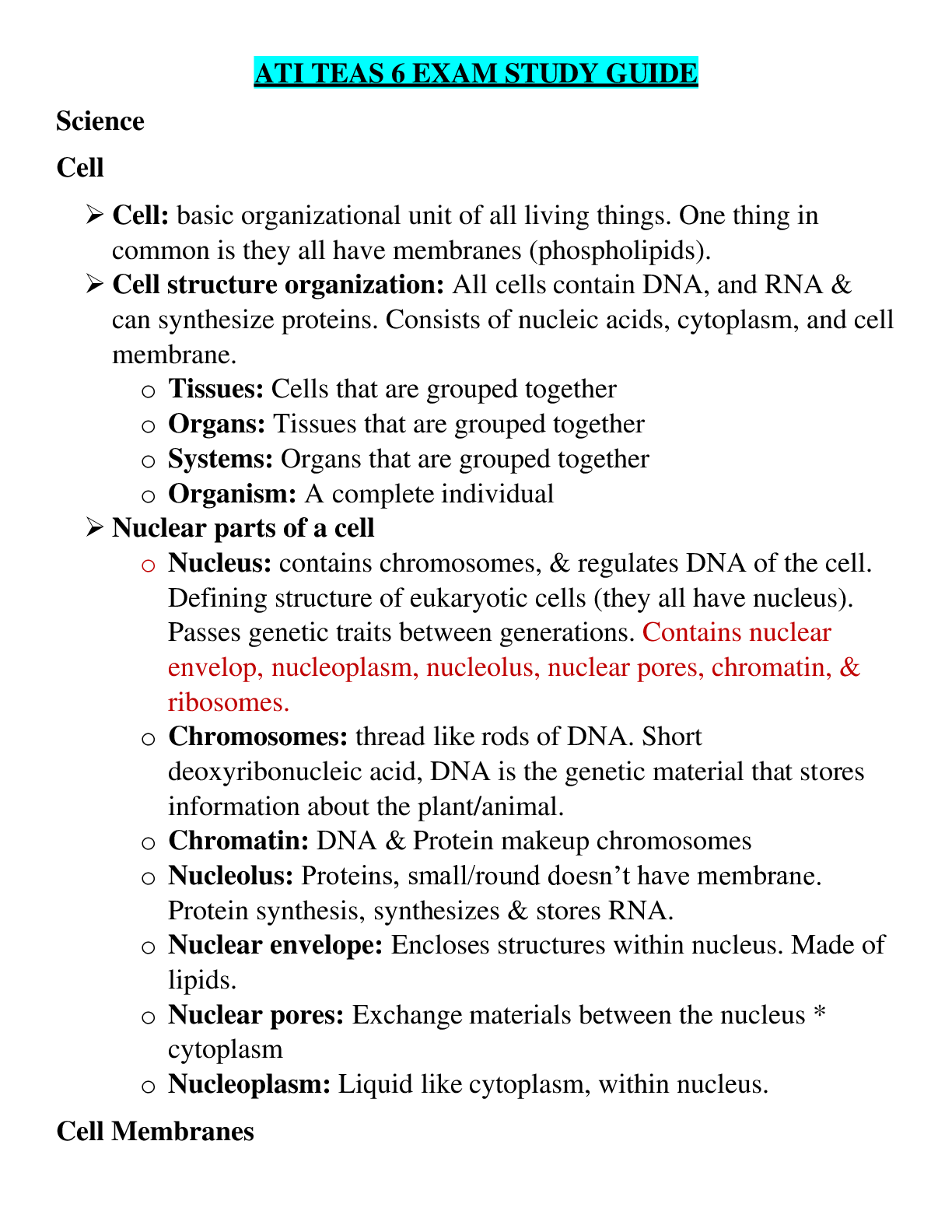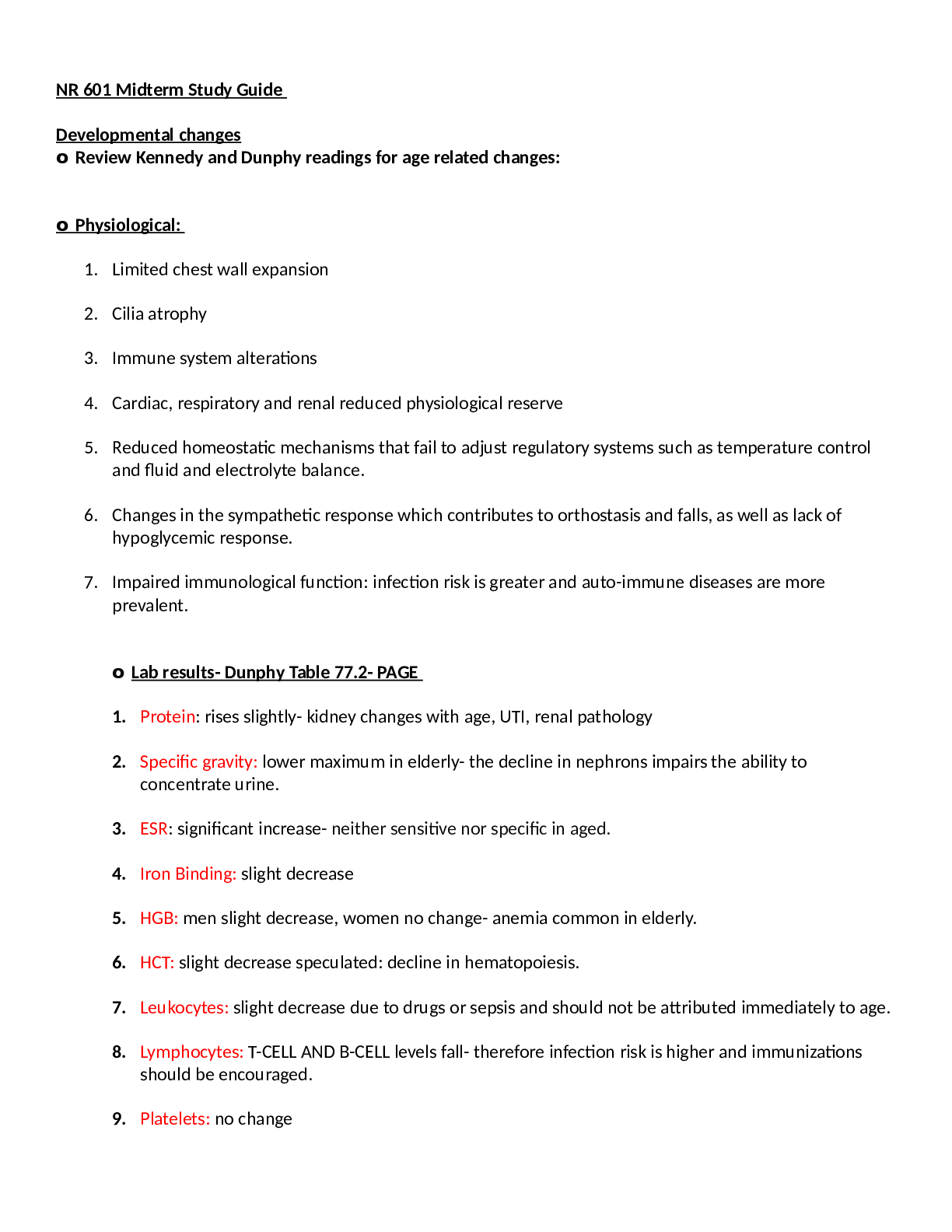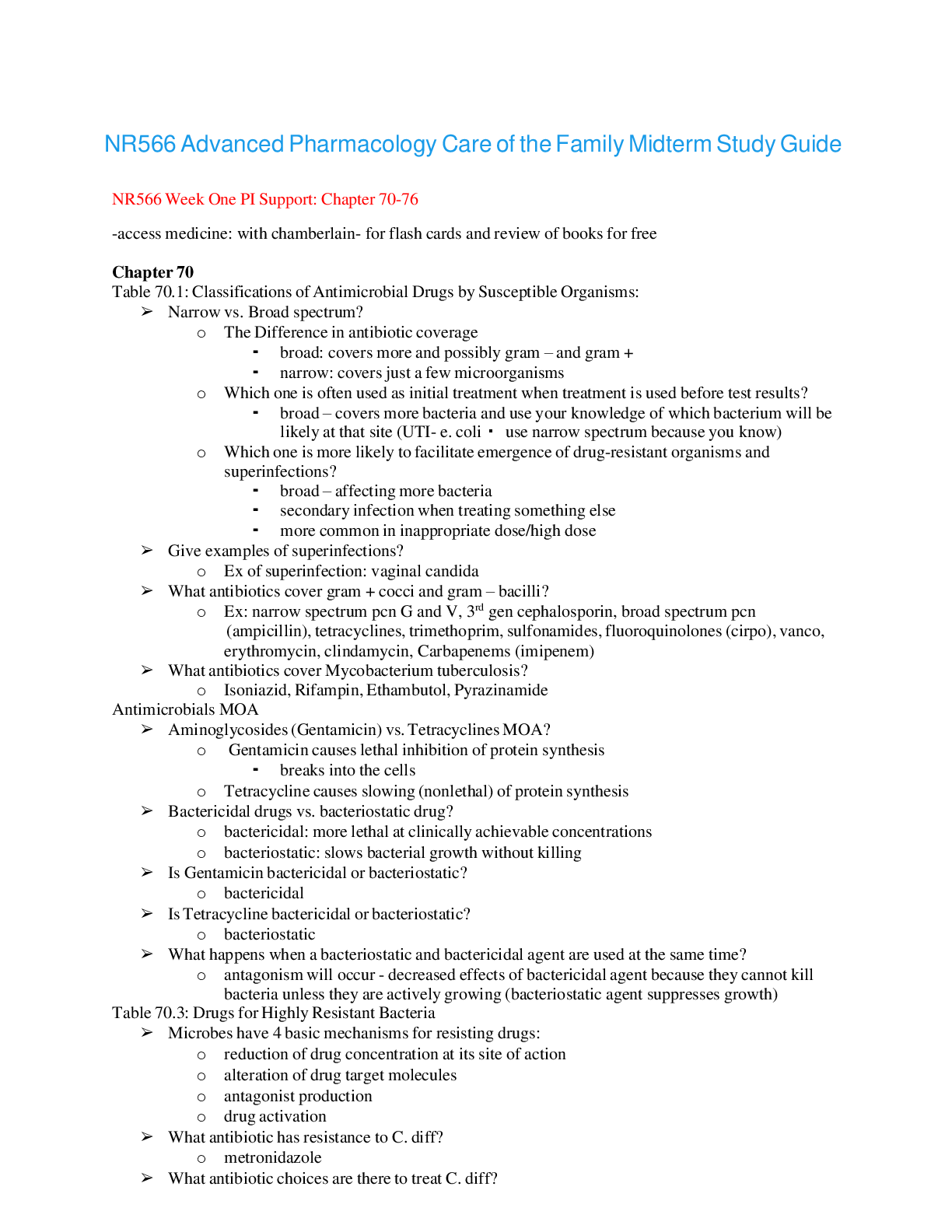*NURSING > STUDY GUIDE > NUR 2488 /NUR 2488 mental health exam 2 STUDY GUIDE | Rated A | Rasmussen College (All)
NUR 2488 /NUR 2488 mental health exam 2 STUDY GUIDE | Rated A | Rasmussen College
Document Content and Description Below
NUR 2488 /NUR 2488 mental health exam 2 STUDY GUIDE Common symptoms of depression anxiety, hopelessness, loss of interest, loss of pleasure in activities, sadness, fatigue, agitation, social isola... tion, insomnia, etc. Beck's Cognitive Triad 1. A negative, self-deprecating view of self: "I really never do anything well; everyone else seems smarter." 2. A pessimistic view of the world: "Once you're down, you can't get up. Look around, poverty, homelessness, sickness, war, and despair are every place you look." 3. The belief that negative reinforcement (or no validation for the self) will continue: "It doesn't matter what you do; nothing ever gets better. I'll be in this stupid job the rest of my life." Risk for suicide: Questions to ask, High vs Low risk? 1. If a person appears depressed, displays any verbal or behavioral clues, or causes you to be concerned, always ask: "Are you thinking of harming or killing yourself?" 2. Assess precipitating event: "Is there something difficult you are facing?" 3. Assess risk factors as well as protective factors. 4. Assess history of suicide (e.g., in family, friends), degree of hopelessness and helplessness, and lethality of plan. 5. If there is a history of a suicide attempt, assess: • Intent: Is there a high probability of being discovered? • Lethality: Was the method used highly lethal or less lethal? • Injury: Did the patient suffer physical harm? (e.g., Was the patient admitted to an intensive care unit?) 6. Determine whether the patient's age, medical condition, or psychiatric diagnosis causes the patient to be at higher risk. 7. Red flags include the following: • The patient suddenly changes from sad or depressed to happy and peaceful. Often a decision to commit suicide gives a feeling of relief and calm. • The patient gives away treasured possessions. 8. If the patient is to be managed on an outpatient basis, also assess the following: • Social supports • Significant others' knowledge of the signs of potential suicidal ideation (e.g., increasing withdrawal, preoccupation, silence, and remorse) • Knowledge of community resources that the patient and family could use for support during the crisis Overt statements (suicide) "I can't take it anymore." "Life isn't worth living anymore." "I wish I were dead." "Everyone would be better off if I died." Covert statements (suicide) • "It's okay now. Everything will be fine." • "Things will never work out." • "I won't be a problem much longer." • "Nothing feels good to me anymore, and probably never will." • "How can I give my body to medical science?" Behavioral Clues (suicide) Giving away prized possessions Writing farewell notes Making out a will Putting personal affairs in order Having global insomnia Exhibiting a sudden and unexpected improvement in mood after being depressed or withdrawn Neglecting personal hygiene NURSING DIAGNOSES (Depression) Previous suicidal attempts, putting affairs in order, giving away prized possessions, suicidal ideation (has plan, ability to carry it out), overt or covert statements regarding killing self, feelings of worthlessness, hopelessness, helplessness Risk for Suicide Risk for Self-Mutilation Lack of judgment, memory difficulty, poor concentration, inaccurate interpretation of environment, negative ruminations, cognitive distortions Decisional Conflict Impaired Memory Acute Confusion Difficulty with simple tasks, inability to function at previous level, poor problem solving, poor cognitive functioning, verbalizations of inability to cope Ineffective Coping Interrupted Family Processes Risk for Impaired Parent/Infant/Child Attachment Ineffective Role Performance Difficulty making decisions, poor concentration, inability to take action Decisional Conflict Feelings of helplessness, hopelessness, powerlessness Hopelessness Feelings of inability to make positive change in one's life or have a sense of control over one's destiny Powerlessness Ineffective Coping Questioning meaning of life and own existence, inability to participate in usual religious practices, conflict over spiritual beliefs, anger toward spiritual deity or religious representatives Spiritual Distress Impaired Religiosity Risk for Impaired Religiosity Feelings of worthlessness, poor self-image, negative sense of self, self-negating verbalizations, feeling of being a failure, expressions of shame or guilt, hypersensitivity to slights or criticism Chronic Low Self-Esteem Situational Low Self-Esteem Withdrawal, noncommunicativeness, speech that is only in monosyllables, avoidance of contact with others Impaired Social Interaction Social Isolation Risk for Loneliness Vegetative signs of depression: changes in sleeping, eating, grooming and hygiene, elimination, sexual patterns Self Neglect (bathing/hygiene, dressing/grooming) Imbalanced Nutrition: Less Than Body Requirements Disturbed Sleep Pattern Constipation Sexual Dysfunction medications for depression SSRIs, TCAs, MAOIs Selective Serotonin Reuptake Inhibitors (SSRIs) Citalopram (Celexa) Escitalopram (Lexapro) Fluoxetine (Prozac) Fluvoxamine (Luvox) Paroxetine (Paxil) Sertraline (Zoloft) Common side effects include: • Headache, which usually dissipates in a few days • Nausea, which usually dissipates in a few days • Sleeplessness and/or drowsiness during day, which usually dissipates in a few weeks • Tremors and/or dizziness • Sexual problems: reduces sexual drive, problems having and enjoying sex • Agitation, feeling jittery and nervous; rare serotonin syndrome; rare activation of suicidal ideation PATIENT AND FAMILY TEACHING ABOUT SELECTIVE SEROTONIN REUPTAKE INHIBITORS • Selective serotonin reuptake inhibitors (SSRIs) may cause sexual dysfunction or lack of sex drive. Inform nurse or physician. • SSRIs may cause insomnia, anxiety, and nervousness. Inform nurse or physician. • SSRIs may interact with other medications. Be sure physician knows other medications patient is taking (e.g., digoxin, warfarin). SSRIs should not be taken within 14 days of the last dose of a monoamine oxidase inhibitor (MAOI). • No over-the-counter drug should be taken without first notifying physician. • Common side effects include fatigue, nausea, diarrhea, dry mouth, dizziness, tremor, and sexual dysfunction or lack of sex drive. • Because of the potential for drowsiness and dizziness, patient should not drive or operate machinery until these side effects are ruled out. • Alcohol should be avoided. SSRIs may act synergistically, and people report increased effects of alcohol (e.g., one drink can seem like two). Alcohol is also a central nervous system (CNS) depressant that may work against the desired effect of the SSRI. • Liver and renal function tests should be performed and blood counts checked periodically. • Medication should not be discontinued abruptly. People report such effects as dizziness, nausea, diarrhea, muscle jerkiness, and tremors. If side effects from the SSRIs become bothersome, patient should ask physician about changing to a different drug. Abrupt cessation can lead to serotonin withdrawal. • SSRIs should be used with caution in the elderly and in pregnant women. The physician should take into account the benefits versus the risk in these populations, as well as all patients taking SSRIs or any kind of antidepressant. • Any of the following symptoms should be reported to a physician immediately: • Increase in depression or suicidal thoughts • Rash or hives • Rapid heartbeat • Sore throat • Difficulty urinating • Fever, malaise • Anorexia and weight loss • Unusual bleeding • Initiation of hyperactive behavior • Severe headache Tricyclic Antidepressants (TCAs) Amitriptyline (Elavil) Clomipramine (Anafranil) Desipramine (Norpramin) Doxepin (Sinequan) Imipramine (Tofranil) Maprotiline (Ludiomil) Nortriptyline (Pamelor) Protriptyline (Vivactil) Trimipramine (Surmontil) Amoxapine (Asendin) Common side effects include: • Dry mouth • Constipation • Bladder problems (hard to empty bladder, weak urine stream, men with enlarged prostate may be more affected) • Sexual problems include reduced sex drive, problems having and enjoying sex • Blurred vision, which usually dissipates quickly • Drowsiness PATIENT AND FAMILY TEACHING ABOUT TRICYCLIC ANTIDEPRESSANTS (TCAs) • The patient and family should be informed that improvement in mood may take from 7 to 28 days after initiation of treatment. Up to 6 to 8 weeks may be required for the full effect to be reached and for major depressive symptoms to subside. The family should reinforce this frequently to the depressed family member because depressed people have trouble remembering and respond to ongoing reassurance. • The patient should be reassured that drowsiness, dizziness, and hypotension usually subside after the first few weeks. • When the patient starts taking tricyclic antidepressants (TCAs), the patient should be cautioned to be careful working around machines, driving cars, and crossing streets because of possible altered reflexes, drowsiness, or dizziness. • Alcohol can block the effects of antidepressants. The patient should be told to refrain from drinking alcohol. • If possible, the patient should take the full dose at bedtime to reduce the experience of side effects during the day. • If the patient forgets the bedtime dose (or the once-a-day dose), the next dose should be taken within 3 hours; otherwise, the patient should wait until the usual medication time the next day. The patient should not double the dose. • Suddenly stopping TCAs can cause nausea, altered heartbeat, nightmares, and cold sweats in 2 to 4 days. The patient should call the physician or take one dose of TCA until the physician can be contacted. Monoamine Oxidase Inhibitors (MAOIs) Isocarboxazid (Marplan) Phenelzine (Nardil) Tranylcypromine (Parnate) Selegiline (Eldepryl) • MAOIs are always used as second-line treatment and only used in depressions that are resistant to other medications and treatments • MAOIs have high risk of hypertensive crisis • If taken with any foods high in tyramine or any sympathomimetic drugs can lead to cerebral hemorrhage or death. COMMON ADVERSE REACTIONS TO AND TOXIC EFFECTS OF MONOAMINE OXIDASE INHIBITORS ADVERSE REACTIONS: • Hypotension • Sedation, weakness, fatigue • Insomnia • Changes in cardiac rhythm • Muscle cramps • Anorgasmia or sexual impotence • Urinary hesitancy or constipation • Weight gain TOXIC EFFECTS: • Severe headache • Stiff, sore neck • Flushing; cold, clammy skin • Tachycardia • Severe nosebleeds, dilated pupils • Chest pain, stroke, coma, death • Nausea and vomiting 1. Patient should go to local emergency department immediately—blood pressure should be checked. 2. One of the following may be given to lower blood pressure: • 5 mg intravenous phentolamine (Regitine) or • Oral chlorpromazine or • Nifedipine (Procardia) (calcium channel blocker), 10 mg sublingually FOODS THAT CAN INTERACT WITH MONOAMINE OXIDASE INHIBITORS Avocados, especially if overripe; fermented bean curd; fermented soybean; soybean paste; broad beans (fava bean pods); sauerkraut, Figs, especially if overripe; bananas in large amounts (banana peel is extremely high in tyramine), Meats that are fermented, smoked, cured, or otherwise aged; spoiled meats; liver, unless very fresh, Fermented varieties: bologna, pepperoni, salami, air-dried sausages, Pickled herring and smoked salmon negligible; lungfish row, sliced schmaltz herring in oil, salmon mousse; dried, pickled, or cured fish; fish that is fermented, smoked, or otherwise aged; spoiled fish, Practically all cheeses, especially hard cheeses. Yeast extract (e.g., Marmite, Bovril), Some imported beers, tap (draft) beers, some wines, Chianti, Protein dietary supplements; soups (may contain protein extract); shrimp paste; soy sauce. DRUGS THAT CAN INTERACT WITH MONOAMINE OXIDASE INHIBITORS • Over-the-counter medications for colds, allergies, or congestion (any product containing ephedrine, phenylephrine hydrochloride, or phenylpropanolamine) • Tricyclic antidepressants (e.g., imipramine, amitriptyline) • Narcotics • Antihypertensives (e.g., methyldopa, guanethidine, reserpine) • Amine precursors (e.g., levodopa, l-tryptophan) • Sedatives (e.g., alcohol, barbiturates, benzodiazepines) • General anesthetics • Stimulants (e.g., amphetamines, cocaine) SYMPTOMS AND INTERVENTIONS FOR SEROTONIN SYNDROME Symptoms: • Hyperactivity or restlessness • Tachycardia → cardiovascular shock • Fever → hyperpyrexia • Elevated blood pressure • Altered mental status (e.g., delirium) • Irrationality, mood swings, hostility • Seizures → status epilepticus • Myoclonus, incoordination, tonic rigidity • Abdominal pain, diarrhea, bloating • Apnea → death Emergency Measures: 1. Discontinue offending agent(s) 2. Initiate symptomatic treatment: • Serotonin receptor blockade: cyproheptadine, methysergide, propranolol • Cooling blankets, chlorpromazine for hyperthermia • Dantrolene, diazepam for muscle rigidity or rigors • Anticonvulsants • Artificial ventilation • Paralysis INTERVENTIONS and rationales FOR ACUTE MANIA: COMMUNICATION (Bipolar) 1. Use firm and calm approach: "John, come with me. Eat this sandwich." 1. Structure and control are provided for patient who is out of control. Feelings of security can result: "Someone is in control." 2. Use short and concise explanations or statements. 2. Short attention span limits comprehension to small bits of information. 3. Remain neutral; avoid power struggles and value judgments. 3. Patient can use inconsistencies and value judgments as justification for arguing and escalating mania. 4. Be consistent in approach and expectations. 4. Consistent limits and expectations minimize potential for patient's manipulation of staff. 5. Have frequent staff meetings to plan consistent approaches and to set agreed-on limits. 5. Consistency of all staff is needed to maintain controls and minimize manipulation by patient. 6. With other staff, decide on limits, tell patient in simple, concrete terms with consequences; for example, "John, do not yell at or hit Peter. If you cannot control yourself, we will help you" or "The seclusion room will help you feel less out of control and prevent harm to yourself and others." 6. Clear expectations help patient experience outside controls as well as understand reasons for medication, seclusion, or restraints (if unable to control behaviors). 7. Hear and act on legitimate complaints. 7. Underlying feelings of helplessness are reduced, and acting-out behaviors are minimized. 8. Firmly redirect energy into more appropriate and constructive channels. 8. Distractibility is the nurse's most effective tool during the patient's manic phase. INTERVENTIONS FOR ACUTE MANIA: SAFETY AND PHYSICAL NEEDS (Bipolar) 1. Maintain low level of stimuli in patient's environment (e.g., away from bright lights, loud noises, and people). 1. Decreases escalating anxiety. 2. Provide structured solitary activities with nurse or aide. 2. Structure provides security and focus. 3. Provide frequent high-calorie fluids. 3. Prevents dangerous levels of dehydration. 4. Provide frequent rest periods. 4. Prevents exhaustion. 5. Redirect violent behavior through physical exercise (e.g., walking) 5. Physical exercise can decrease tension and provide focus. 6. When warranted in acute mania, use antipsychotics and seclusion to minimize physical harm via physician's order. 6. Exhaustion and death can result from dehydration, lack of sleep, and constant physical activity. 7. Observe for signs of lithium toxicity. 7. There is a small margin of safety between therapeutic and toxic doses. 8. Protect patient from giving away money and possessions. Hold valuables in hospital safe until rational judgment returns. 8. Patient's "generosity" is in fact a symptom of the disease and can lead to catastrophic financial ruin for patient and family. INTERVENTIONS FOR ACUTE MANIA: Nutrition (Bipolar) 1. Monitor intake, output, and vital signs. 1. Adequate fluid and caloric intakes are ensured; development of dehydration and cardiac collapse is minimized. 2. Offer frequent high-calorie protein drinks and finger foods (e.g., sandwiches, fruit, milkshakes). 2. Constant fluid and calorie replacement are needed. Patient may be too active to sit at meals. Finger foods allow "eating on the run." 3. Frequently remind patient to eat. "Tom, finish your milkshake." "Sally, eat this banana." 3. During mania the patient is unaware of bodily needs and is easily distracted. Needs supervision to eat. INTERVENTIONS FOR ACUTE MANIA: Sleep (Bipolar) 1. Encourage frequent rest periods during the day. 1. Lack of sleep can lead to exhaustion and death. 2. Keep patient in areas of low stimulation. 2. Relaxation is promoted and manic behavior is minimized. 3. At night, provide warm baths, soothing music, and medication when indicated. Avoid giving patient caffeine. 3. Promotes relaxation, rest, and sleep. INTERVENTIONS FOR ACUTE MANIA: Hygiene (Bipolar) 1. Supervise choice of clothes; minimize flamboyant and bizarre dress (e.g., garish stripes or plaids and loud, unmatching colors). 1. The potential is decreased for ridicule, which lowers self-esteem and increases the need for manic defense. The patient is helped to maintain dignity. 2. Give simple step-by-step reminders for hygiene and dress. "Here is your razor. Shave the left side...now the right side. Here is your toothbrush. Put the toothpaste on the brush." 2. Distractibility and poor concentration are countered through simple, concrete instructions. Elimination 1. Monitor bowel habits; offer fluids and foods that are high in fiber. Evaluate need for laxative. Encourage patient to go to the bathroom. 1. Fecal impaction resulting from dehydration and decreased peristalsis is prevented. POTENTIAL NURSING DIAGNOSES FOR BIPOLAR DISORDERS Diagnosis: Risk for Injury AEB Excessive and constant motor activity Poor judgment Lack of rest and sleep Poor nutritional intake (excessive or relentless mix of above behaviors can lead to cardiac collapse) Diagnosis: Risk for Other-Directed Violence Risk for Self-Directed Violence Risk for Suicide Interrupted Family Processes ineffective Coping Ineffective Impulse Control AEB Loud, profane, hostile, combative, aggressive, demanding behaviors Intrusive and taunting behaviors Inability to control behavior Rage reaction Diagnosis: Defensive Coping Ineffective Coping Disabled Family Coping Ineffective Relationship AEB Manipulative, angry, or hostile verbal and physical behaviors Impulsive speech and actions Property destruction or lashing out at others in a rage reaction Bipolar medications: Lithium and other anticonvulsants Bipolar Mania levels (Communication) HYPOMANIA: 1. Talks and jokes incessantly, is "life of the party," and gets irritated when not center of attention 2. Treats everyone with familiarity and confidentiality; often borders on crude 3. Talk is often sexual—can reach obscene, inappropriate propositions to total strangers 4. Talk is fresh; flits from one topic to the next; marked by pressure of speech ACUTE MANIA: 1. May change suddenly from laughing to anger or depression; mood is labile 2. Becomes inappropriately demanding of people's attention, and intrusive nature repels others 3. Speech may be marked by profanities and crude sexual remarks to everyone (nursing staff in particular) 4. Speech marked by flight of ideas, in which thoughts race and fly from topic to topic; may have clang associations DELIRIOUS MANIA: 1. Totally out of touch with reality 4. Most likely has clang associations Bipolar Mania levels (Affect and Thinking) HYPOMANIA: 1. Full of pep and good humor, feelings of euphoria and sociability; may show inappropriate intimacy with strangers 2. Feels boundless self-confidence and enthusiasm. Has elaborate schemes for becoming rich and famous. Initially, schemes may seem plausible. 3. Judgment often poor. Gets involved with schemes in which job, marriage, or financial status may be destroyed. 4. May write large quantities of letters to rich and famous people regarding schemes or may make numerous worldwide telephone calls 5. Decreased attention span to internal and external cues ACUTE MANIA: 1. Good humor gives way to increased irritability and hostility, short-lived period of rage, especially when not getting his or her way or when controls are set on behavior. May have quick shifts of mood from hostility to docility 2. Grandiose plans are totally out of contact with reality. Thinks he or she is a musician, prominent businessman, great politician, or religious figure, without any basis in fact. 3. Judgment is extremely poor 5. Decreased attention span and distractibility are intensified DELIRIOUS MANIA: 1. May become destructive or aggressive—totally out of control 2. May experience undefined hallucinations and delirium Bipolar Mania levels (Physical Behavior) HYPOMANIA: 1. Overactive, distractible, buoyant, and busily occupied with grandiose plans (not delusions); goes from one action to the next 2. Increased sexual appetite; sexually irresponsible and indiscreet. Illegitimate pregnancies in hypomanic women and venereal disease in both men and women are common. Sex used for escape, not for relating to another human being 3. May have voracious appetite, eat on the run, or gobble food during brief periods 4. May go without sleeping; unaware of fatigue. However, may be able to take short naps 5. Financially extravagant, goes on buying sprees, gives money and gifts away freely, can easily go into debt ACUTE MANIA: 1. Extremely restless, disorganized, and chaotic. Physical behavior may be difficult to control. May have outbursts, such as throwing things or becoming briefly assaultive when crossed. 2. No time for sex—too busy. Poor concentration, distractibility, and restlessness are severe. 3. No time to eat—too distracted and disorganized 4. No time for sleep—psychomotor activity too high; if unchecked, can lead to exhaustion and death 5. Same as in hypomania but in the extreme DELIRIOUS MANIA: 1. Dangerous state. Incoherent, extremely restless, disoriented, and agitated. Hyperactive. Motor activity is totally aimless (must have physical or chemical restraints to prevent exhaustion and death) 2. Same as in acute mania but in the extreme 3. Same as in acute mania but in the extreme 5. Too disorganized to do anything LITHIUM SIDE EFFECTS AND SIGNS OF LITHIUM TOXICITY Expected Side Effects Fine hand tremor, polyuria, and mild thirst Mild nausea and general discomfort Weight gain Early Signs of Toxicity Nausea, vomiting, diarrhea, thirst, polyuria, slurred speech, muscle weakness (Medication should be withheld, blood lithium levels measured, and dosage re-evaluated.) Advanced Signs of Toxicity 1.5 to 2 mEq/L Coarse hand tremor, persistent gastrointestinal upset, mental confusion, muscle hyperirritability, electroencephalographic (EEG) changes, incoordination Severe Toxicity 2 to 2.5 mEq/L Ataxia, serious EEG changes, blurred vision, clonic movements, large output of dilute urine, tinnitus, blurred vision, seizures, stupor, severe hypotension, coma; death is usually secondary to pulmonary complications Symptoms may progress rapidly; coma, cardiac dysrhythmia, peripheral circulatory collapse, proteinuria, oliguria, and death (There is no known antidote for lithium poisoning. The drug is stopped, and excretion is hastened. If patient is alert, an emetic is administered. Otherwise, gastric lavage and treatment with urea, mannitol, and aminophylline hasten lithium excretion) Lithium therapeutic level <0.4 to 1 mEq/L ANTIEPILEPTIC (anticonvulsants) DRUGS Carbamazepine (Tegretol) • Agranulocytosis and aplastic anemia are most serious adverse reactions • Blood levels should be monitored throughout first 8 weeks because drug induces liver enzymes that speed its own metabolism. Dosage may need to be adjusted to maintain serum level of 6-8 mg/L. • Immediate action when severe adverse reactions appear (e.g., confusion, difficulty breathing, irregular heartbeat, skin rash or hives, jaundice) Equetro A sustained-release form of carbamazepine Divalproex/valproate (Depakote) • Baseline liver function tests should be performed and results monitored at regular intervals. Hepatitis, although rare, has been reported, with fatalities in children • Severe adverse reactions include fever, chills, right upper quadrant pain, dark urine, malaise, jaundice/confusion, significant drowsiness • Best use for men and older women. Can cause birth defects in pregnant women Lamotrigine (Lamictal) • Life-threatening rash reported in 3 out of every 1000 individuals (Stevens-Johnson syndrome) • Rare but potential septic meningitis risk with lamotrigine • Use caution when renal, hepatic, or cardiac function is impaired Topiramate (Topamax) • Used in acute mania or in combination with other drugs • Adverse effects include weight loss, cognitive side effects, fatigue, dizziness, and paresthesia • Used off-label; not presently FDA approved for bipolar disorder Oxcarbazepine (Trileptal) • Structural variant of carbamazepine • Thought to have better side effect profile and more favorable drug interaction profiles • Not yet FDA approved for bipolar disorders • Used off-label Generalized anxiety disorder (GAD) a chronic psychiatric disorder associated with severe distress different from other anxiety disorders in that there is pervasive cognitive dysfunction, impaired functioning, and poor health-related outcomes. GAD also differs from other anxiety disorders in that patients do not fear a specific external object or situation, and there is no distinct symptomatic reaction pattern. Basically, GAD is characterized by excessive, persistent, and uncontrollable anxiety, and by excessive worrying. It is sometimes referred to as the "worry disease." Obsessive-Compulsive Disorder (OCD) Obsessions are defined as thoughts, impulses, or images that persist and recur so that they cannot be dismissed from the mind. Obsessions often seem senseless to the individual who experiences them, although they still cause the individual to experience severe anxiety. Common obsessions include fear of hurting a loved one or fear of contamination. Compulsions are ritualistic behaviors that an individual feels driven to perform in an attempt to reduce anxiety. Common compulsions are repetitive hand washing and checking a door multiple times to make sure it is locked. In doing this we are performing a compulsive act that temporarily reduces high levels of anxiety. The primary gain is achieved by compulsive rituals, but because the relief is only temporary, the compulsive act must be repeated many times. panic level of anxiety the most extreme form and results in markedly disturbed behavior. An individual is not able to process events in the environment and may lose touch with reality. The resulting behavior may be confusion, shouting, screaming, or withdrawal. Hallucinations, or false sensory perceptions such as seeing people or objects that are not present, may be experienced by people at panic levels of anxiety. Physical behavior may be erratic, uncoordinated, and impulsive. Automatic behaviors are used to reduce and relieve anxiety, although such efforts may be ineffective. Acute panic may lead to exhaustion. Agoraphobia a phobic disorder, is intense, excessive anxiety or fear about being in places or situations from which help might not be available, and escape might be either difficult or embarrassing. The feared places are avoided by the individual in an effort to control anxiety. Examples of situations that are commonly avoided by patients with agoraphobia are being alone outside; being alone at home; traveling in a car, bus, or airplane; being on a bridge; and riding in an elevator. Avoidance behaviors can be debilitating and life constricting. DEFENSE MECHANISM: Repression ADAPTIVE Man forgets his wife's birthday after a marital fight. MALADAPTIVE Woman is unable to enjoy sex after having pushed out of awareness a traumatic sexual incident from childhood. DEFENSE MECHANISM: Sublimation ADAPTIVE Woman who is angry with her boss writes a short story about a heroic woman. By definition, use of sublimation is always constructive. MALADAPTIVE None DEFENSE MECHANISM: Regression ADAPTIVE Four-year-old boy with a new baby brother starts sucking his thumb and wanting a bottle. MALADAPTIVE Man who loses a promotion starts complaining to others, does sloppy work, misses appointments, and arrives late for meetings. DEFENSE MECHANISM: Displacement ADAPTIVE Patient criticizes a nurse after his family fails to visit. MALADAPTIVE Child who is unable to acknowledge fear of his father becomes fearful of animals. DEFENSE MECHANISM: Projection ADAPTIVE Man who is unconsciously attracted to other women teases his wife about flirting. MALADAPTIVE Woman who has repressed an attraction toward other women refuses to socialize. She fears another woman will make homosexual advances toward her. DEFENSE MECHANISM: Compensation ADAPTIVE Short man becomes assertively verbal and excels in business. (nice car...small penis) MALADAPTIVE Individual drinks alcohol when self-esteem is low to diffuse discomfort temporarily. DEFENSE MECHANISM: Reaction formation ADAPTIVE Recovering alcoholic constantly preaches about the evils of alcoholic beverages. MALADAPTIVE Mother who has an unconscious hostility toward her daughter is overprotective to protect daughter from harm, interfering with daughter's normal growth and development. DEFENSE MECHANISM: Denial ADAPTIVE Man reacts to news of the death of a loved one by saying, "No, I don't believe you. The doctor said he was fine." MALADAPTIVE Woman whose husband died 3 years earlier still keeps his clothes in the closet and talks about him in the present tense. DEFENSE MECHANISM: Conversion ADAPTIVE Student is unable to take a final examination because of a terrible headache. MALADAPTIVE Man becomes blind after seeing his wife flirt with other men. DEFENSE MECHANISM: Undoing ADAPTIVE After flirting with her male secretary, a woman brings her husband tickets to a show. MALADAPTIVE Man with rigid and moralistic beliefs and repressed sexuality is driven to wash his hands to gain composure when around attractive women. DEFENSE MECHANISM: Rationalization ADAPTIVE Employee says, "I didn't get the raise because the boss doesn't like me." MALADAPTIVE Father who thinks his son was fathered by another man excuses his malicious treatment of the boy by saying, "He is lazy and disobedient," when that is not the case. DEFENSE MECHANISM: Identification ADAPTIVE Five-year-old girl dresses in her mother's shoes and dress and meets her father at the door. MALADAPTIVE Young boy thinks a neighborhood pimp with money and drugs is someone to emulate. DEFENSE MECHANISM: Introjection ADAPTIVE After his wife's death, husband has transient complaints of chest pains and difficulty breathing—the symptoms his wife had before she died. MALADAPTIVE Young child whose parents were overcritical and belittling grows up thinking that she is inferior. She has taken on her parent's evaluation of her as part of her self-image. DEFENSE MECHANISM: Suppression ADAPTIVE Businessman who is preparing to make an important speech later in the day is told by his wife that morning that she wants a divorce. Although visibly upset, he puts the incident aside until after his speech, when he can give the matter his total concentration MALADAPTIVE A woman who feels a lump in her breast shortly before leaving for a 3-week vacation puts the information in the back of her mind until after returning from her vacation. NURSING DIAGNOSES examples (anxiety) Anxiety (moderate, severe, panic) Ineffective coping Deficient diversional activity Social isolation Hopelessness R/T Concern that a panic attack will occur Exposure to phobic object or situation Presence of obsessive thoughts Recurrent memories of traumatic event Fear of panic attacks Avoidance behaviors (phobia, agoraphobia) SHORT- AND LONG-TERM OUTCOMES FOR SPECIFIC ANXIETY DISORDERS ANXIETY DISORDER Phobia Patients will: Develop skills at reframing anxiety-provoking situation (date). Work with nurse/clinician to desensitize self to feared object or situation (date). Demonstrate one new relaxation skill that works well for them (date). Generalized anxiety disorder Patients will: • State increased ability to make decisions and problem solve. • Demonstrate ability to perform usual tasks even though still moderately anxious by (date). • Demonstrate one cognitive or behavioral coping skill that helps reduce anxious feelings by (date). Obsessive-compulsive disorder Patients will: • Demonstrate techniques that can distract and distance self from thoughts that are anxiety producing by (date). • Decrease time spent in ritualistic behaviors. • Demonstrate increased amount of time spent with family and friends and on pleasurable activities. • State they have more control over intrusive thoughts and rituals by (date). Posttraumatic stress disorder Patients will: • Attend support group at least once a week by (date). • Increase social support by one each month with aid of nurse/counselor. • Report increase in restful sleep periods. • Report decrease in nightmares or flashbacks. • Demonstrate at least one new anxiety reduction technique (cognitive or behavioral) that works well for them. Posttraumatic stress disorder (PTSD) occurs in people who have experienced a highly traumatic event, witnessed a traumatic event (e.g., watching a friend die an atrocious death), or been repeatedly exposed to stories about a traumatic event. Events instigating PTSD often involve threats of death or serious injury to self and others, inducing feelings of intense fear, helplessness, or horror Potential SYMPTOMS OF PTSD • Episodes of repeated reliving of the event • Intrusive memories of the traumatic event are experienced with the same fear and horror that occurred with the actual event, as if the person is reliving the actual event. One type of reliving of the event is in the form of dissociated and unbidden memories and feelings that are called flashbacks. Flashbacks are dissociative reactions in which the individual feels or acts as if the traumatic event were recurring. Often there is a trigger—such as a car backfiring, which could be a trigger for a war veteran, or hearing or reading about a rape, which could be a trigger for a person re-experiencing the horror and helplessness associated with a brutal sexual assault. • Dreams/nightmares that re-enact the horror of the event are also common in people with PTSD. • Avoidance of people or situations that could trigger memories of the event. • Persistent emotional blunting, unresponsiveness to surroundings. Numbing of feelings, such as feeling detached or estranged from others or feeling empty inside. Activities that used to be pleasurable no longer hold any value. • Increased autonomic hyperarousal with hypervigilance. Increased hypervigilance may take the form of becoming exceedingly alert and constantly on the lookout for danger, suddenly becoming angry or irritable, having trouble sleeping or concentrating, or having an exaggerated startle response. Often the person may exhibit reckless or self-destructive behavior. • Transient psychotic symptoms such as realization, delusions, and hallucinations. • Associated features may include major depression. Panic attacks, substance abuse, and suicidal ideation are often present. MEDICATIONS COMMONLY USED IN THE TREATMENT OF ANXIETY DISORDERS Benzodiazepines Alprazolam (Xanax) Diazepam (Valium) Lorazepam (Ativan) Oxazepam (Serax) Chlordiazepoxide (Librium) Clorazepate (Tranxene) Anxiolytic effects result from depressing neurotransmission in the limbic system and cortical areas. Useful for short-term treatment of anxiety; dependence and tolerance develop. These drugs are NOT indicated as a primary treatment for OCD or PTSD. Buspirone hydrochloride (BuSpar) Alleviates anxiety, but works best before benzodiazepines have been tried. Less sedating than benzodiazepines. Does not appear to produce physical or psychological dependence. Requires 3 or more weeks to be effective. Selective Serotonin Reuptake Inhibitors (SSRIs) First Line Citalopram (Celexa) Escitalopram (Lexapro) (Escitalopram not useful with SAD or PD) Fluoxetine (Prozac) Fluvoxamine (Luvox) Paroxetine (Paxil) Sertraline (Zoloft) Dual-Action Reuptake Inhibitors (Serotonin and Norepinephrine) (SNRIs) First Line Duloxetine (Cymbalta) (Acts within 1 to 2 weeks) Venlafaxine (Effexor) Tricyclic Antidepressants (TCAs) Second or Third Line Amitriptyline Elavil Clomipramine Anafranil Desipramine Norpramin Doxepin Sinequan Imipramine Tofranil Maprotiline Ludiomil Nortriptyline Pamelor Trimipramine Surmontil Amoxapine Asendin Beta-Blockers Propranolol (Inderal) Atenolol (Tenormin) Used to relieve physical symptoms of anxiety, as in performance anxiety (stage fright). Act by attaching to sensors that direct arousal messages. PATIENT AND FAMILY MEDICATION TEACHING: ANXIOLYTIC DRUGS 1. Caution the patient and family: • Not to increase dose or frequency of ingestion without prior approval of therapist • That these medications reduce the ability to handle mechanical equipment (e.g., cars, saws, and other machinery) • Not to drink alcoholic beverages or take other antianxiety drugs because depressant effects of both would be potentiated • To avoid drinking beverages containing caffeine because they decrease the desired effects of the drug 2. Recommend that the patient taking benzodiazepines avoid becoming pregnant because these drugs increase the risk of congenital anomalies. 3. Advise the patient not to breast-feed because these drugs are excreted in the milk and would have adverse effects on the infant. 4. Teach a patient who is taking monoamine oxidase inhibitors about the details of a tyramine-restricted diet. 5. Teach the patient that: • Cessation of benzodiazepine use after 3 to 4 months of daily use may cause withdrawal symptoms such as insomnia, irritability, nervousness, dry mouth, tremors, convulsions, and confusion. • Medications should be taken with, or shortly after, meals or snacks to reduce gastrointestinal discomfort. • Drug interactions can occur: antacids may delay absorption; cimetidine interferes with metabolism of benzodiazepines, causing increased sedation; central nervous system depressants, such as alcohol and barbiturates, cause increased sedation; serum phenytoin concentration may become too high because of decreased metabolism. Schizophrenia Schizophrenia is a devastating brain disease that targets young people in their teens or early twenties at the beginning of their productive lives. It profoundly disrupts an individual's ability to perceive reality accurately, to think clearly, to use language appropriately, to experience normal emotions, or to engage in normal social/occupational experiences. Hallucinations Auditory—hearing voices or sounds Visual—seeing persons or things Olfactory—smelling odors Gustatory—experiencing tastes Tactile—feeling bodily sensations Neologisms made-up words that have special meaning for the person, for example: "I was going to tell him the mannerologies of his hospitality just won't do." "I want all the vetchkisses to leave the room and let me be." Echolalia the pathological repeating of another's words by imitation and is often seen in people with catatonia. Echolalia is the counterpart of echopraxia, mimicking of the movements of another, which is also seen in catatonia. Clang association the meaningless rhyming of words, often in a forceful manner ("On the track...have a Big Mac...or get the sack"), in which the rhyming is often more important than the context of the word. This form of speech pattern may be seen in individuals with schizophrenia; however, it may also be seen in people in the manic phase of a bipolar disorder or in individuals with a cognitive disorder, such as Alzheimer's disease or HIV-related dementia. Word salad a jumble of words that is meaningless to the listener and perhaps to the speaker as well. It may include a string of neologisms. For example, "I sang out for my mother...for this to hell I went. How long is road? These little said three hills hop aboard, share the appetite of the Christmas mice spread...within three round moons the devil will be washed away." Bizarre behavior • Extreme motor agitation is excited physical behavior, such as running about, in response to inner and outer stimuli, which can be harmful to self as well as to others. • Stereotyped behaviors are motor patterns that originally had meaning to the person (e.g., sweeping the floor, washing windows) but are now mechanical and lack purpose. • Automatic obedience is the performance by a catatonic patient of all simple commands in a robot-like fashion. • Waxy flexibility, seen in catatonia, is evidenced by excessive maintenance of posture. Patients can hold unusual postures for long periods. • Stupor refers to a state in which the catatonic patient is motionless for long periods and may even appear to be in a coma. • Negativism is equivalent to resistance. In active negativism, the patient does the opposite of what he or she is told to do. When a person does not perform activities that are normal expectations, such as getting out of bed, dressing, and eating, the behavior is termed passive negativism (catatonia). POSITIVE SYMPTOMS OF SCHIZOPHRENIA Hallucinations • Auditory • Voices commenting • Voices conversing • Voices commanding • Somatic-tactile • Olfactory • Visual Delusions • Persecutory delusions • Jealous delusions • Grandiose delusions • Religious delusions • Somatic delusions • Delusions of reference • Delusions of being controlled • Delusions of mind reading • Thought broadcasting, insertion, withdrawal Bizarre Behavior • Clothing, appearance • Social and sexual behavior • Aggressive, agitated behavior • Repetitive, stereotyped behavior Positive Formal Thought Disorder and Speech Patterns • Derailment • Tangentiality • Incoherence • Illogicality • Circumstantiality • Pressure of speech • Distractible speech • Clang associations NEGATIVE SYMPTOMS OF SCHIZOPHRENIA Affective Flattening • Unchanging facial expression • Decreased spontaneous movements • Paucity of expressive gestures • Poor eye contact • Inappropriate affect • Lack of vocal inflections Alogia • Poverty of speech • Poverty of content of speech • Blocking Avolition, Apathy • Impaired grooming and hygiene • Lack of persistence at work or school • Physical anergia Anhedonia, Asociality • Few recreational interests or activities • Little sexual interest or activity • Impaired intimacy and closeness • Few relationships with friends or peers Attention Deficits • Social inattentiveness TREATMENT FOCUS AT DIFFERENT PHASES OF SCHIZOPHRENIA (Phase 1) ACUTE: ONSET, EXACERBATION, OR RELAPSE Clinical Focus Crisis intervention Safety Acute symptom stabilization Intervention Acute psychopharmacological treatment Limit setting Supportive and directive care Psychiatric, medical, neurological evaluation Meeting with family Professional Collaboration Inpatient treatment team Residential alternative to hospitalization Community crisis intervention Internist Neurologist SUBACUTE OR CONVALESCENT Social supports Stress and vulnerability assessment Living arrangements Daily activities Economic resources Psychosocial evaluation Linkage with: • Social services • Human services • Community treatment agencies Psychoeducational interventions with families Social work department Health and human services Day treatment or a variety of community support services TREATMENT FOCUS AT DIFFERENT PHASES OF SCHIZOPHRENIA (Phase 2) MAINTENANCE ADAPTIVE PLATEAU Understanding and acceptance of illness Support and teaching Medication teaching and side effect management Direct assistance with situational problems Identification of prodromal and acute symptoms and signs of relapse Continued psychoeducational work with families as needed Community support staff Family support groups Group therapists and self-help groups Practitioners of behavioral therapies using educational models and cognitive restructuring TREATMENT FOCUS AT DIFFERENT PHASES OF SCHIZOPHRENIA (Phase 3) STABLE PLATEAU Social, vocational, and self-care skills Learning or relearning Identification of realistic expectations Adaptation to deficits Attention to details of self-care, social, and work functioning Direct intervention with family and/or employers Cognitive and social skills enhancement Medication maintenance Continued psychoeducational intervention with families as needed Group therapists Social, vocational, and self-care providers Family, employer, community support staff POTENTIAL NURSING DIAGNOSES FOR SCHIZOPHRENIA Disturbed Sensory Perception: auditory or visual Impaired Environmental Interpretation Syndrome Fear Risk for Self-Directed/Other-Directed Violence Ineffective Impulse Control Disturbed Thought Processes † Defensive Coping Disturbed Personal Identity Impaired Environmental Interpretation Syndrome AEB Distorted Thinking Not Based on Reality Persecution: Thinks that others are trying to harm self Jealousy: Thinks that spouse or lover is being unfaithful, or thinks others are jealous of self when they are not Grandeur: Incorrectly thinks he or she has powers and talents or is someone powerful or famous Reference: Believes that all events within the environment are directed at or hold special meaning for self EPS Symptoms Akathisia Acute dystonia Pseudoparkinsonism Tardive dyskinesia [Show More]
Last updated: 1 year ago
Preview 1 out of 26 pages
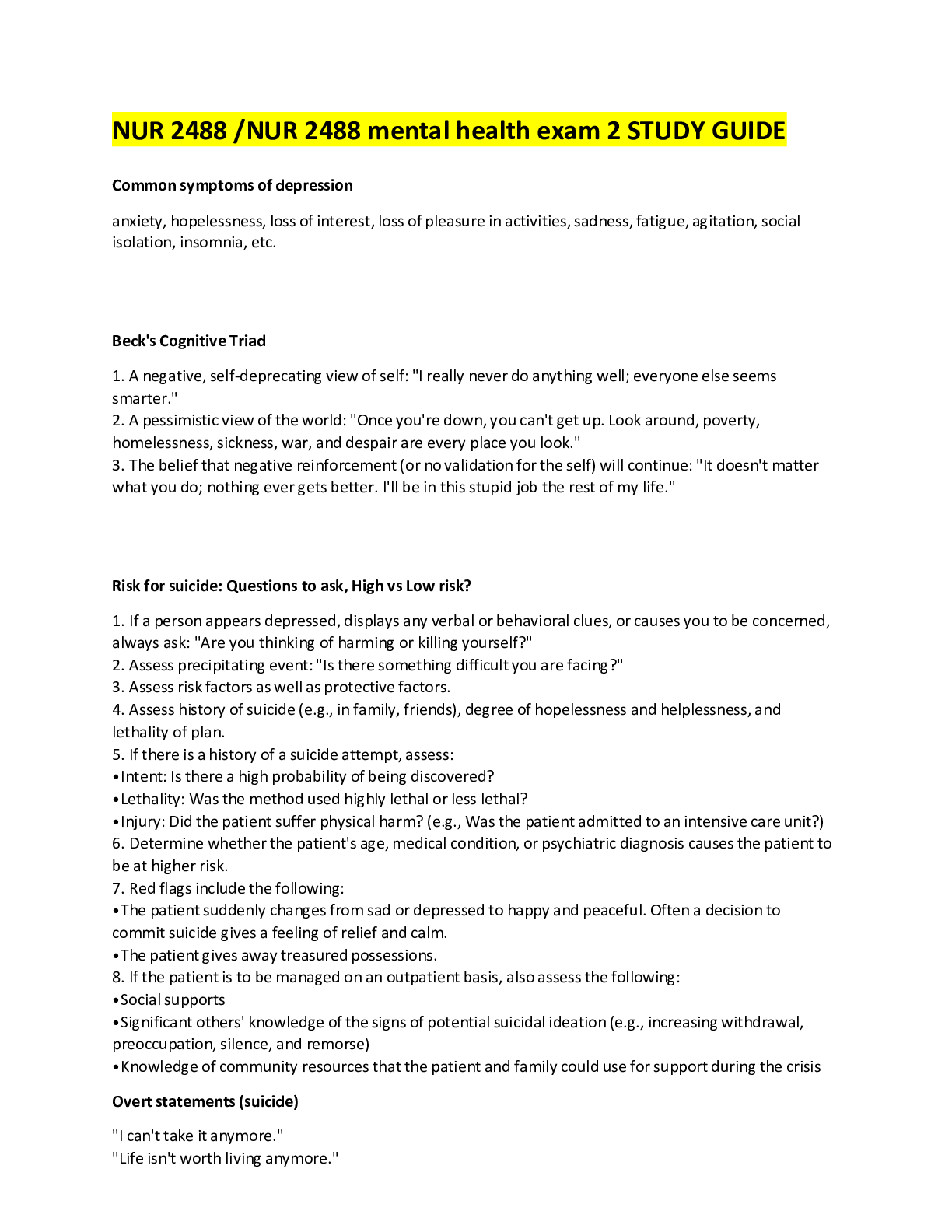
Reviews( 0 )
Document information
Connected school, study & course
About the document
Uploaded On
Nov 19, 2021
Number of pages
26
Written in
Additional information
This document has been written for:
Uploaded
Nov 19, 2021
Downloads
0
Views
37











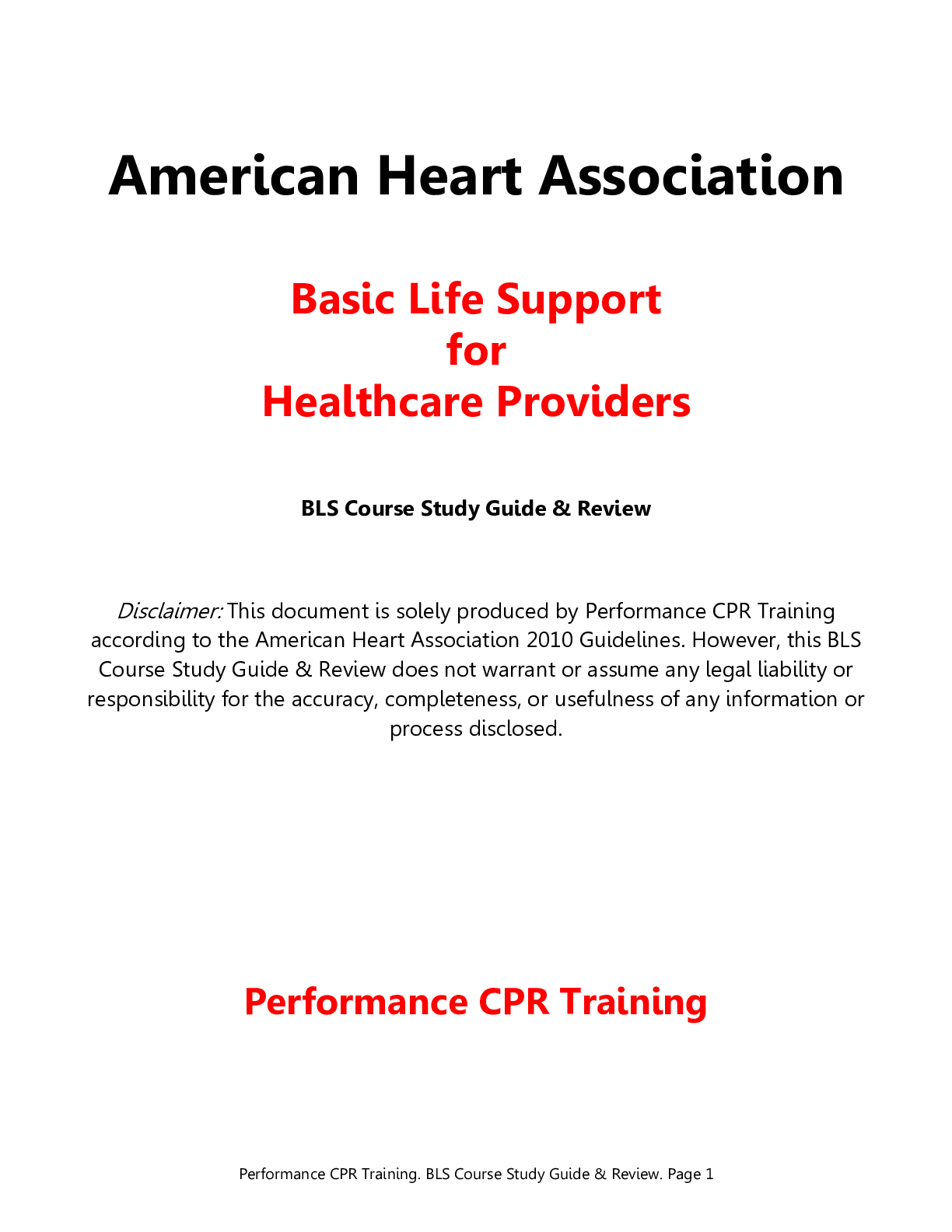
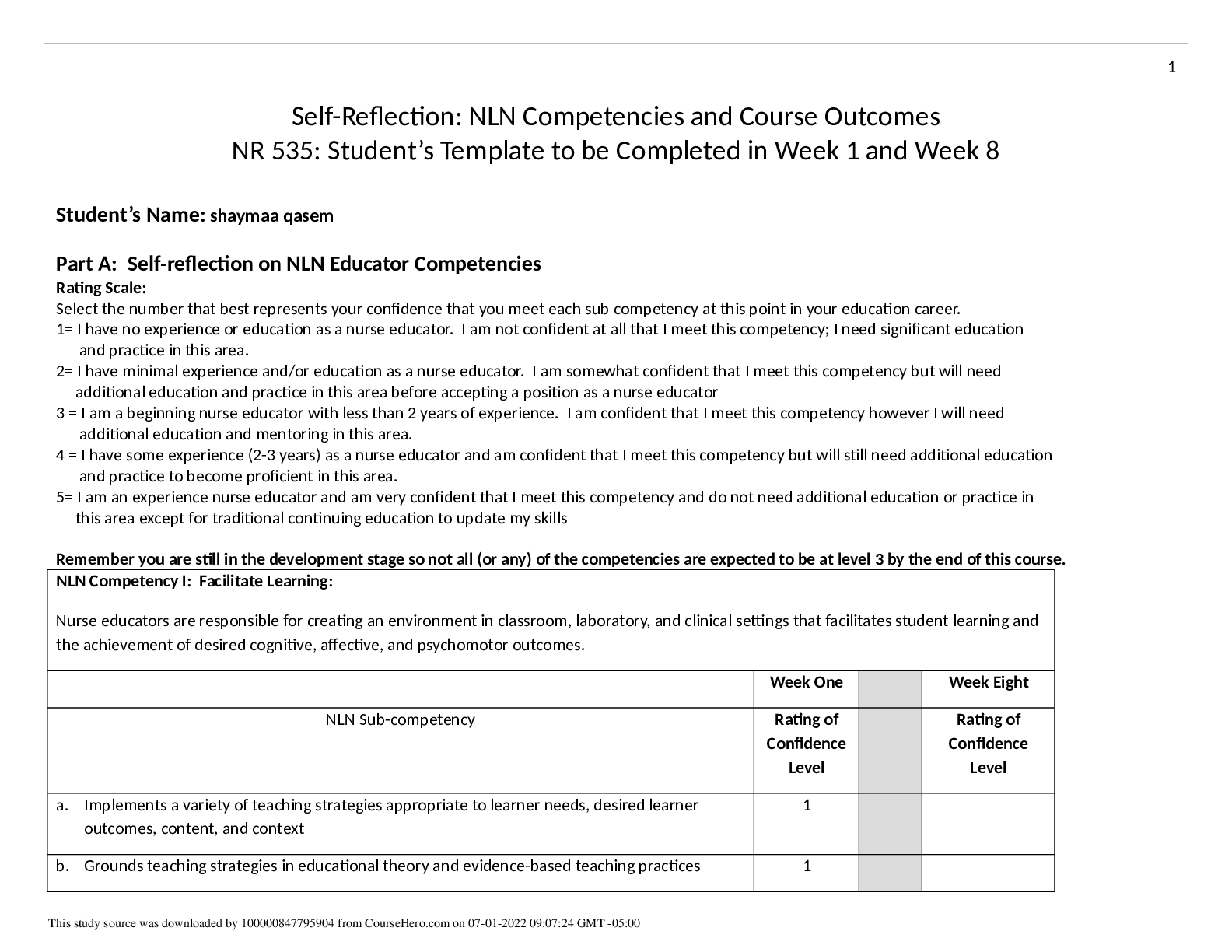
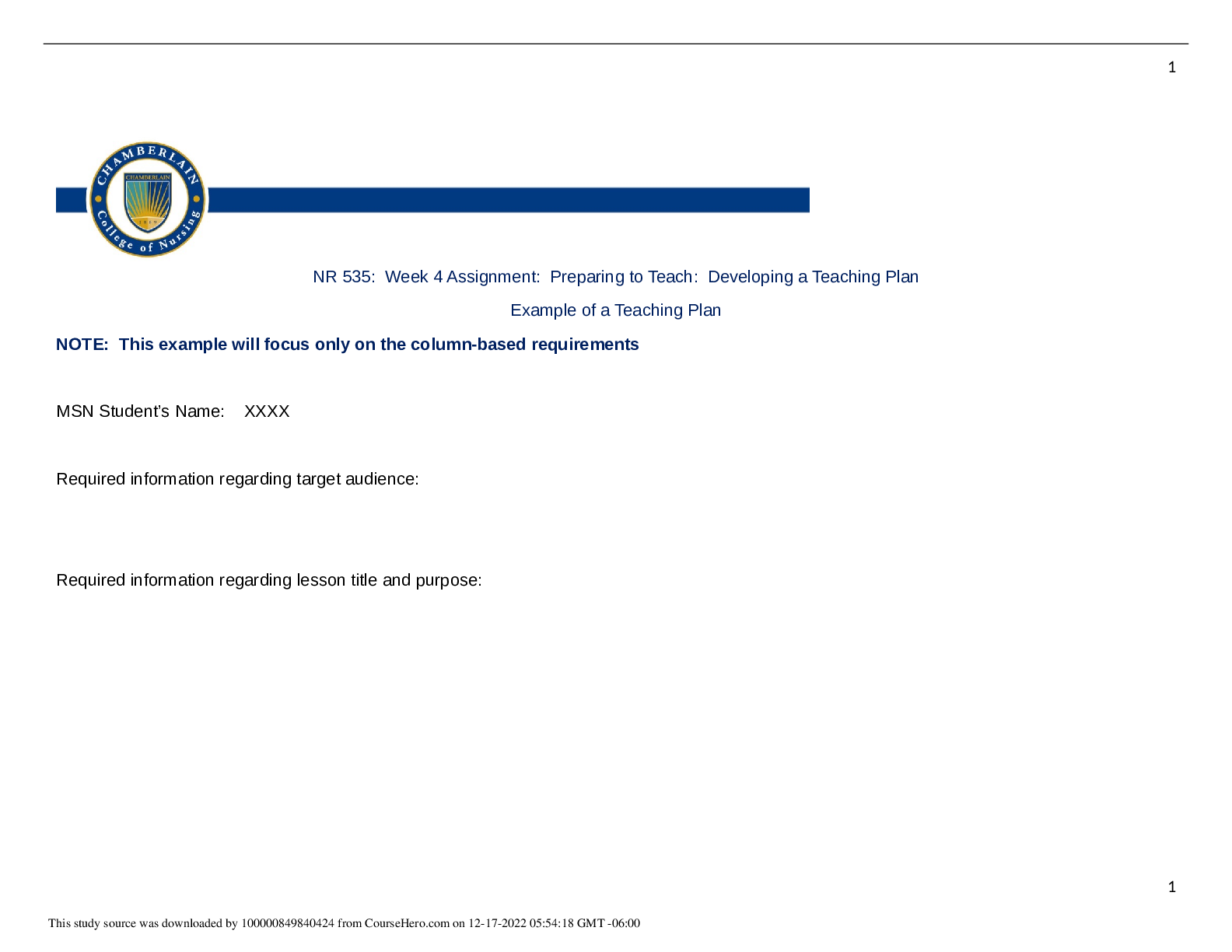
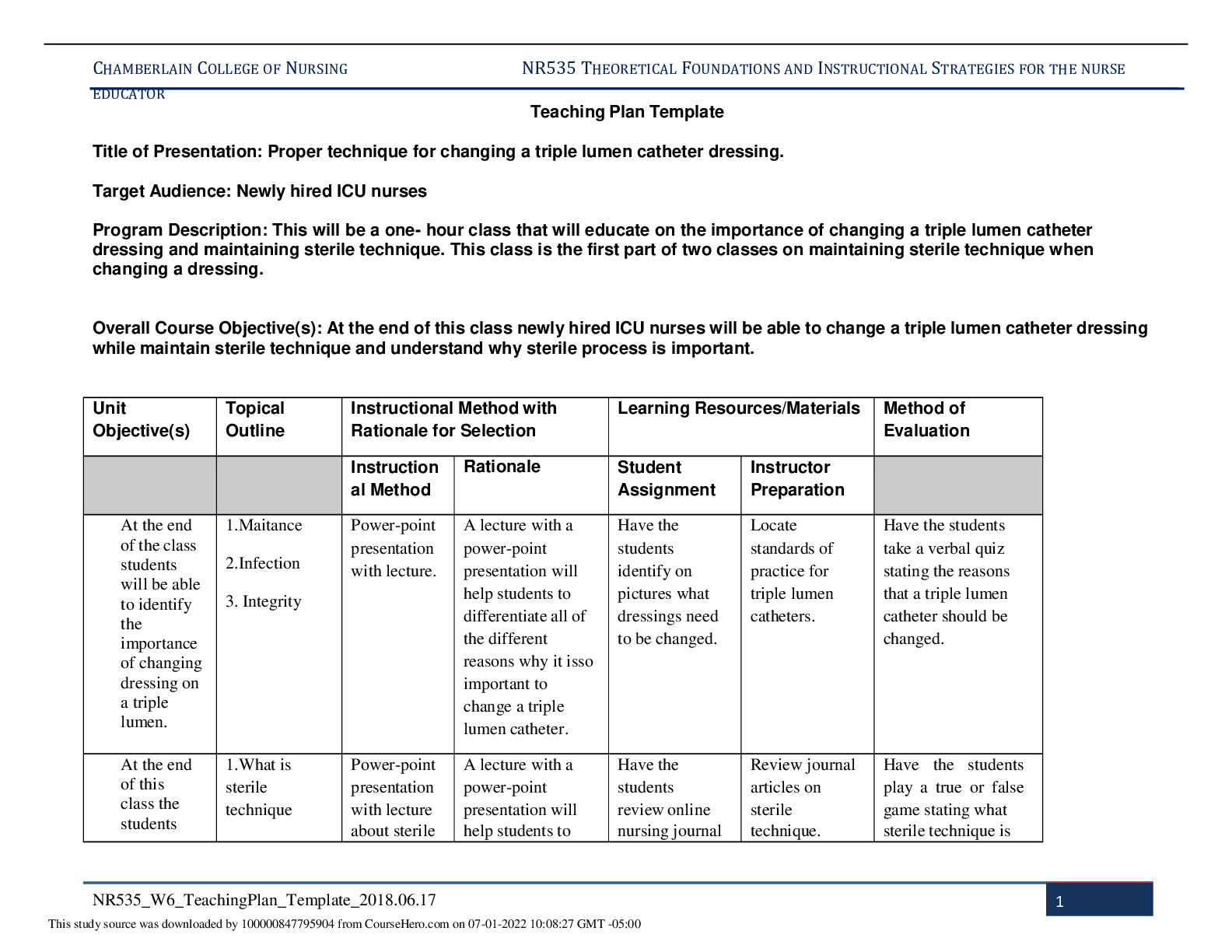
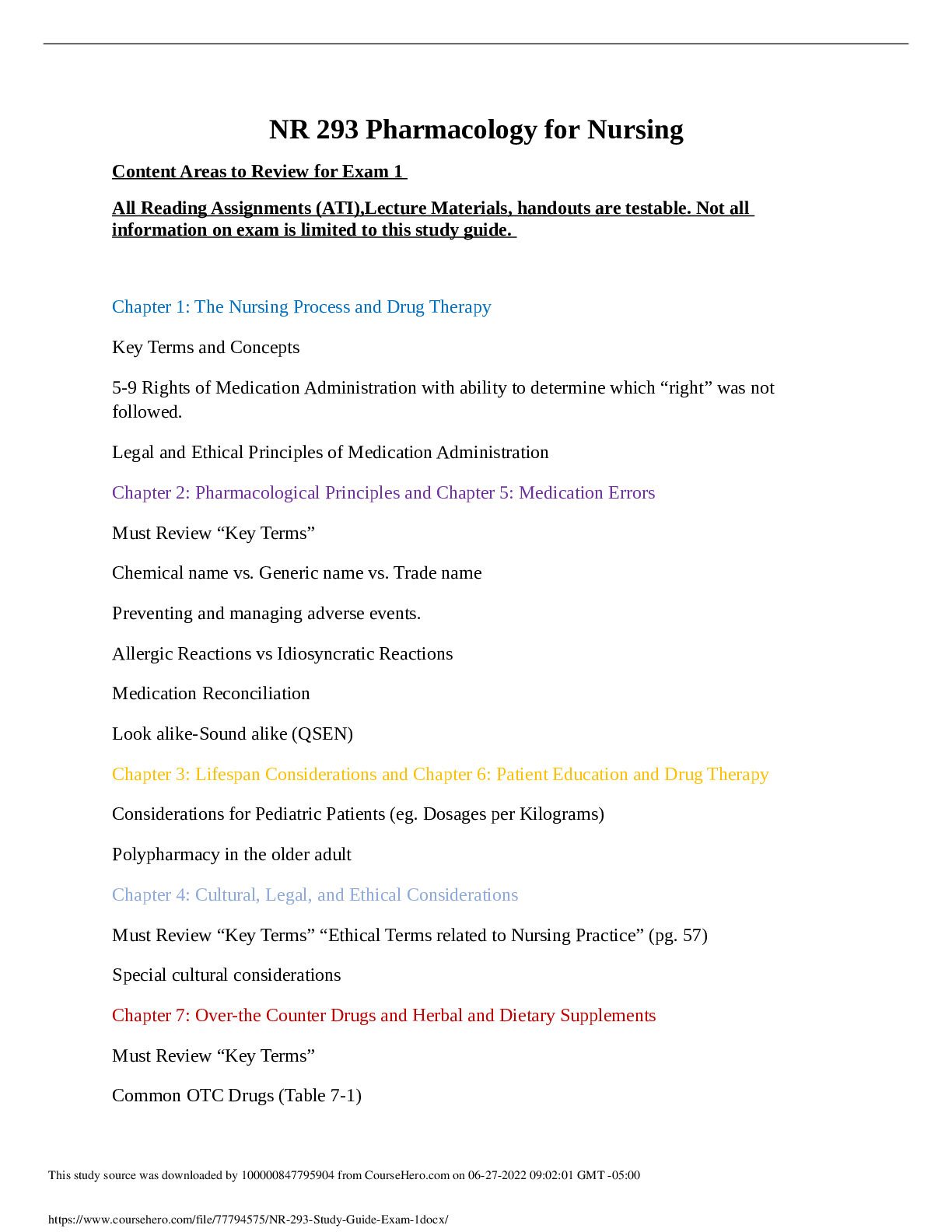
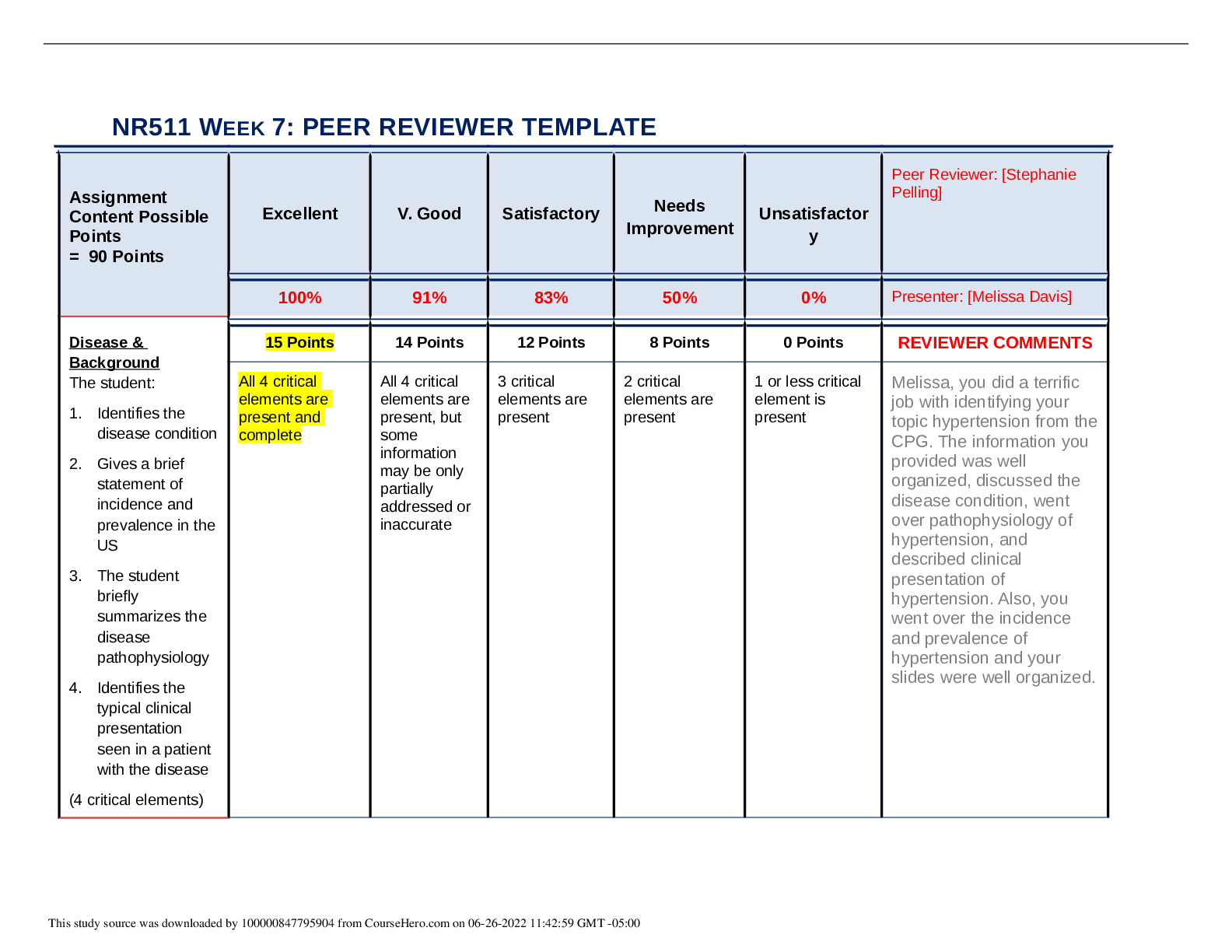
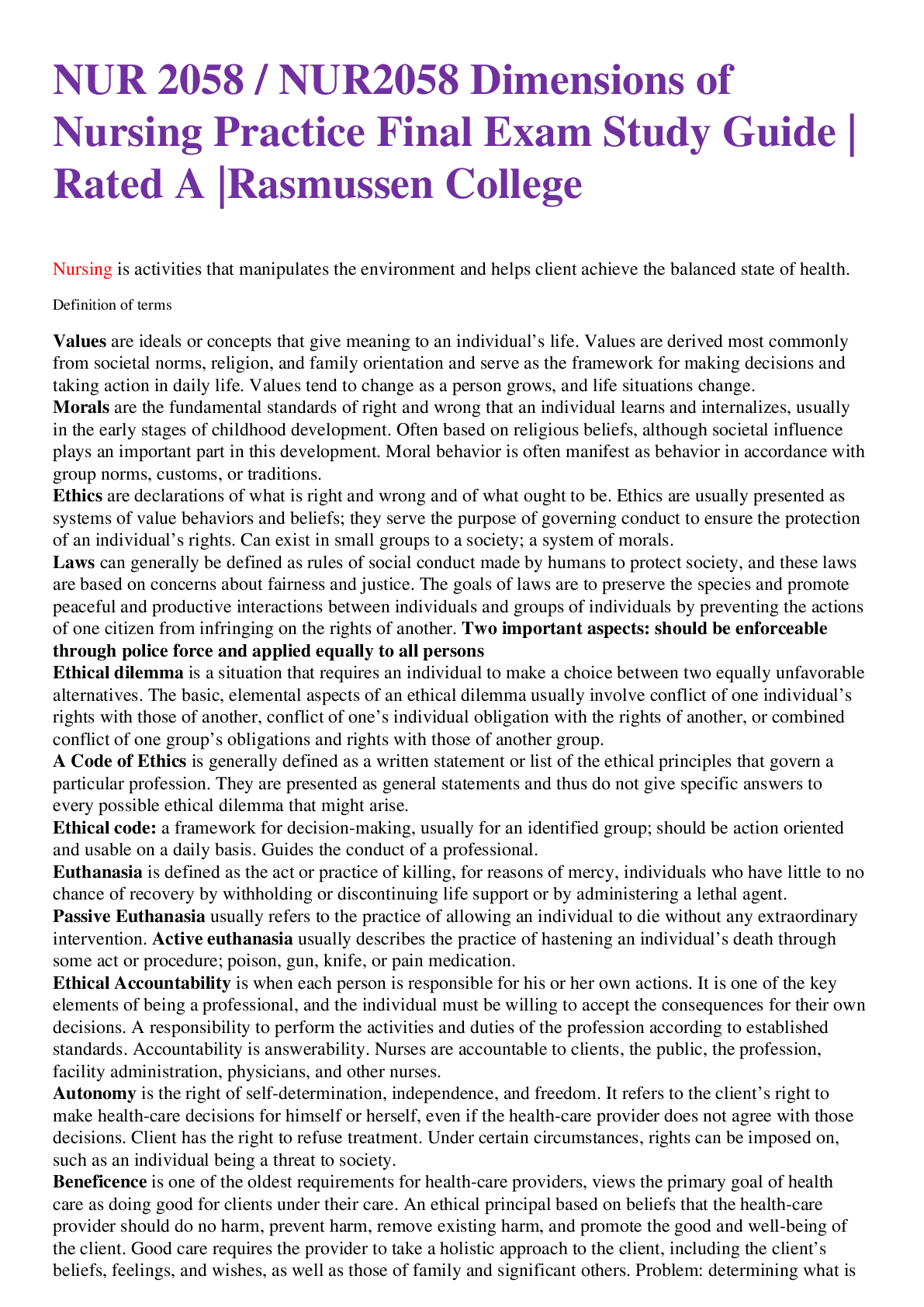


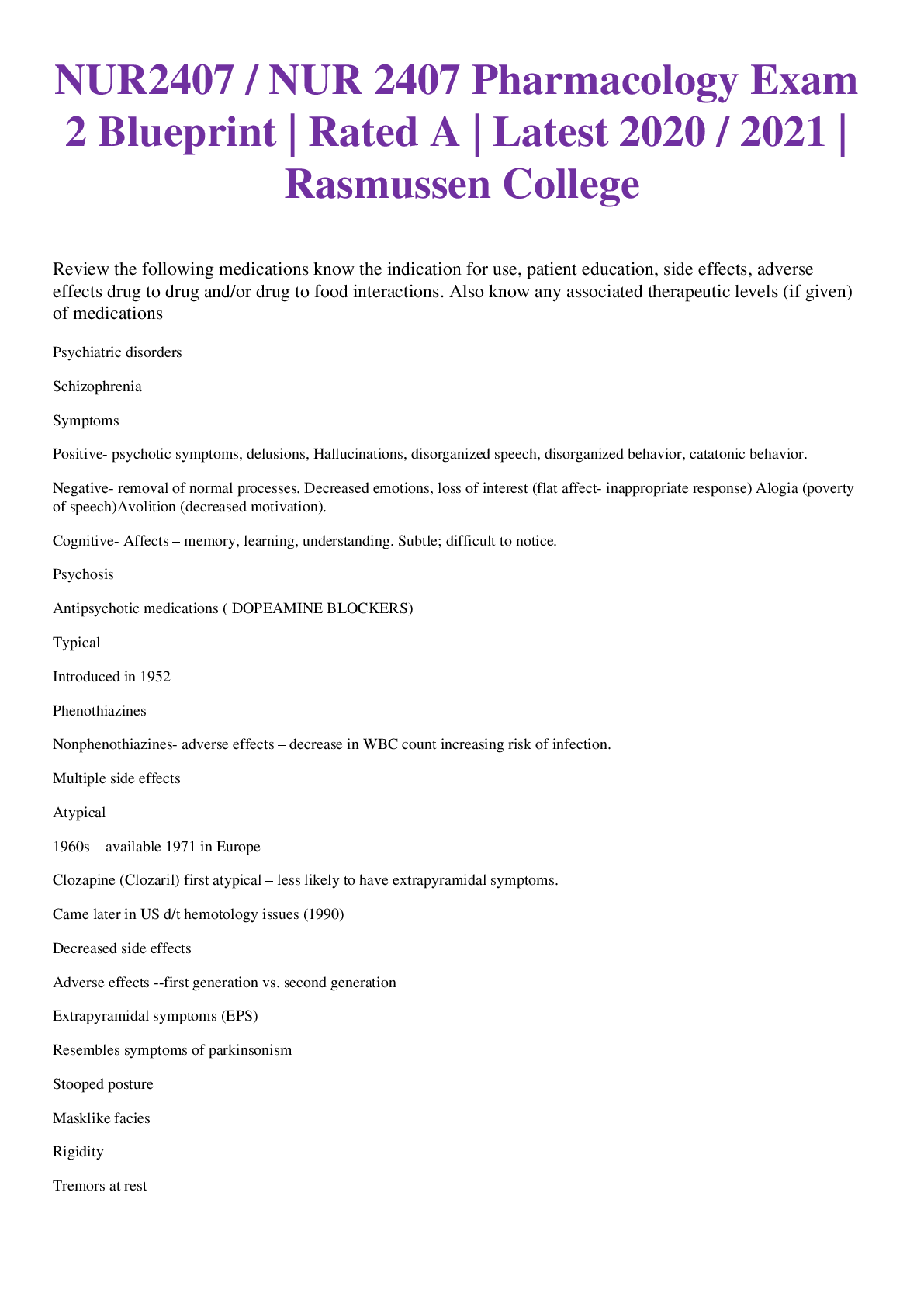
.png)


